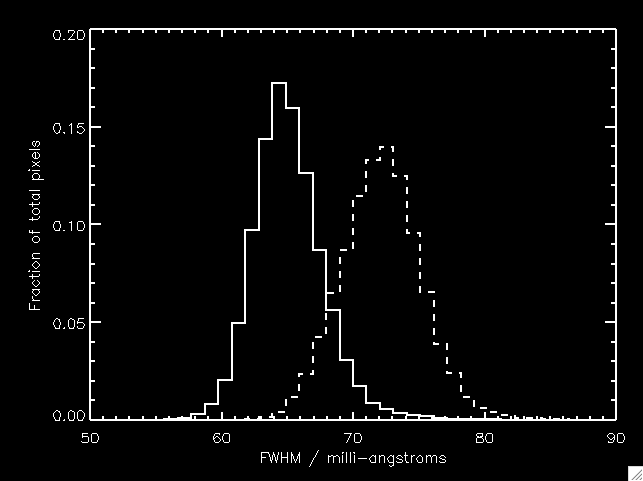The EIS 2" slit#
EIS has two slits available for spectroscopy with widths of 1" and 2". The advantages of using the 2" slit are that you will receive twice as many counts per pixel compared to the 1" slit, and you will be able to raster the same spatial region in X in half as many steps. This is advantageous for improving raster cadence.
For example, to raster over 100" in X with the 1" slit using 30s exposures will take around 50 min. Using the 2" slit requires only 50 exposures, and the exposure time can be reduced to 15s since there will be twice as many counts. Therefore the region can be rastered in only 12.5 min - a factor 4 improvement in cadence.
The disadvantages of using the 2" slit are: spatial resolution is two times worse in the X direction, and the emission line widths are increased in size. It is shown below, however, that the increase in line width is not large.
A further advantage of using the 2" slit occurs for low signal-to-noise data such as from coronal holes or off-limb regions. Since the emission lines have twice as many counts compared to 1" slit data, then the strength of the lines relative to detector features (dark current, warm and hot pixels) will be improved by a factor two.
Emission line width comparison for 1" and 2" slits#
To compare line widths from the 1" and 2" slits, two quiet Sun rasters taken at disk center 1 day apart were studied. The Fe XII 195.12 line was fit with a Gaussian in both data-sets, and histograms of the line width created. These are shown below.

The solid line shows the histogram for the 1" data, and the dashed line shows the histogram for the 2" data. In each case a thermal width of 21 milli-angstroms was subtracted out from the measured width. Taking the weighted average of the histogram distributions gives 65.0 mAng for the 1" slit and 72.0 mAng for the 2" slit. The instrumental width for the 2" slit is thus 7 mAng larger than that for the 1" slit. Taking the 1" instrumental width of 0.054 Ang from Brown et al. (2008, ApJS, 176, 511) thus implies a 2" instrumental width of 0.061 Ang for the SW wavelength band.
The data-sets used were 2008 January 21 16:02 (SYNOP002, 1") and 2008 January 22 16:00 (cam_qs_2as_context, 2"). Both were obtained close to Sun centre. The two rasters have different sizes in the Y-direction (184" and 360", respectively) which may account for the different shapes of the width distributions, since the instrumental widths are known to vary with Y position.
